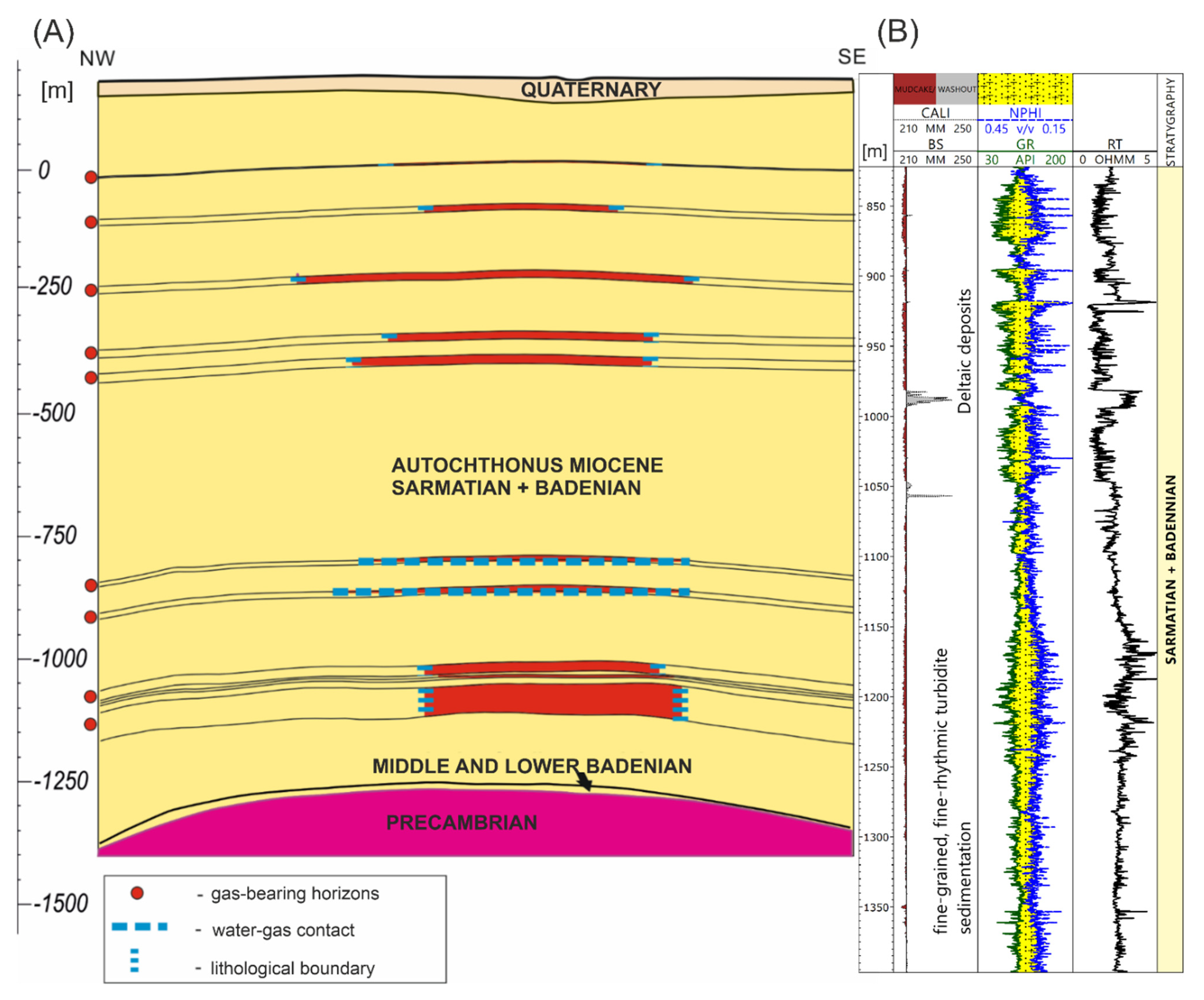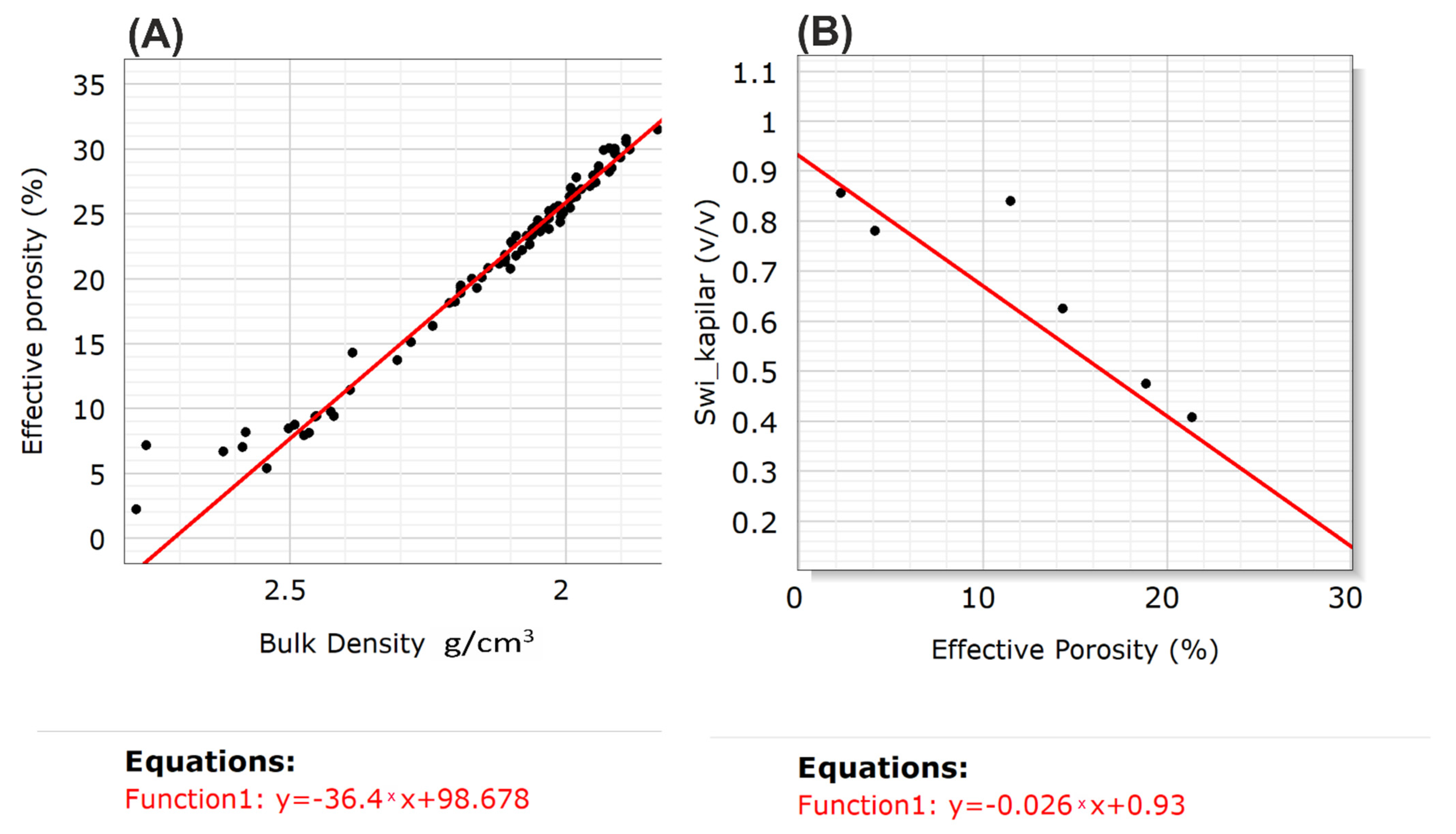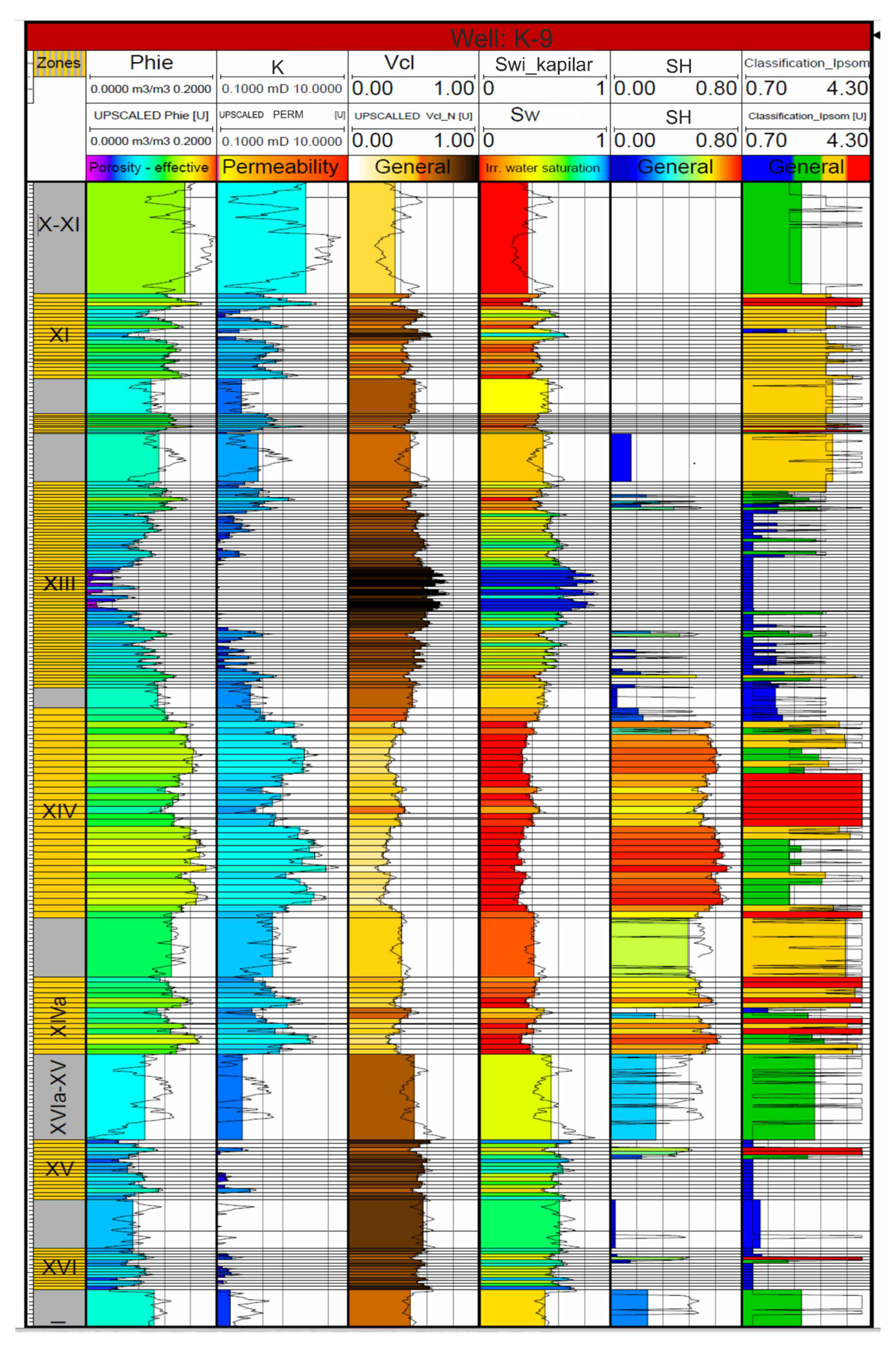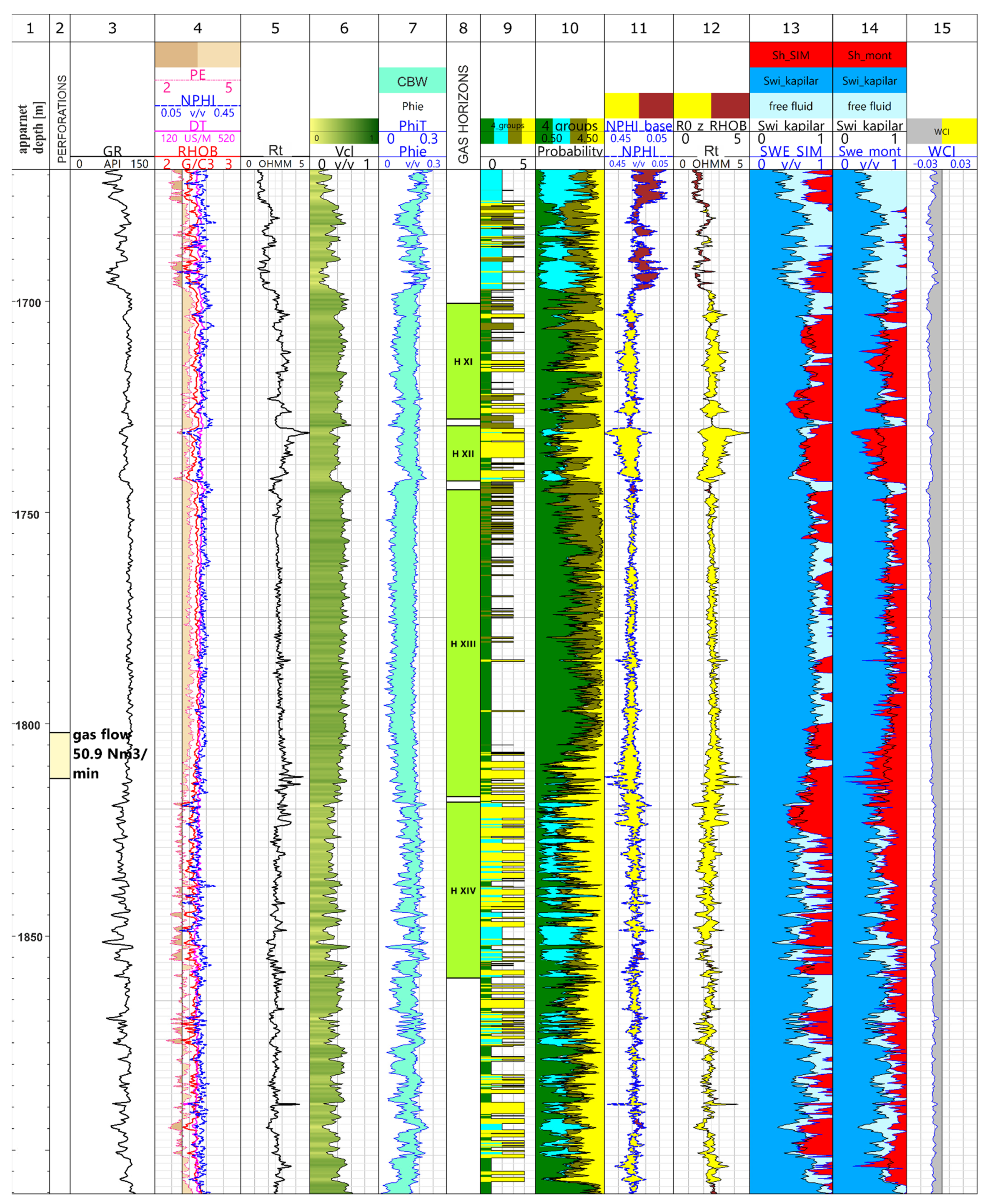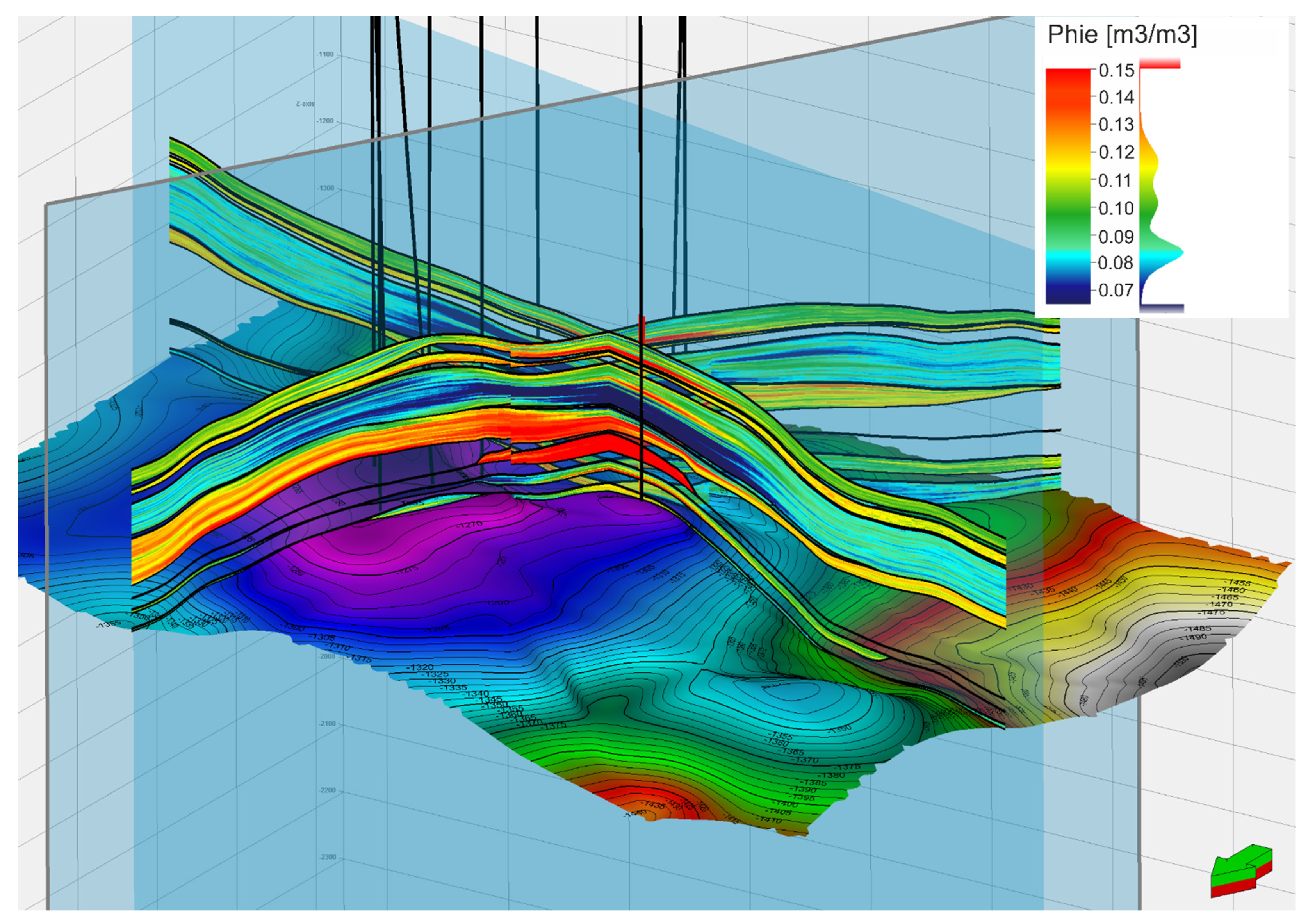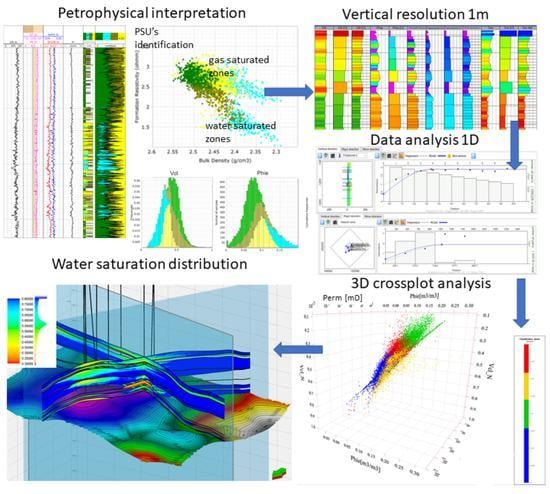2.1. Study Area
The location of the study is an area of multihorizon gas deposits typical of Miocene formations (
Figure 1A). The analyzed area is in the central part of the Carpathian Foredeep, a short distance from the edge of the Carpathian overthrust, and is characterized by an uncomplicated geological structure, both in terms of stratigraphy and tectonics, which consists of three main complexes: (1) Precambrian basement with a strongly eroded morphological surface; (2) autochthonous Miocene sediments subdivided into Sarmatian and Badenian; and (3) Quaternary cover. Eroded Precambrian basement, consisting of quartzite sandstone and shales, is unconformably overlain by Badenian and Sarmatian sediments where many gas-bearing horizons were discovered. The Badenian formation consists of clays, marly clays, marls with thin laminas of mudstones, sandstones, and anhydrites. The Upper Badenian deposits are represented in the entire area by clay and clay–calcareous shales, sometimes interbedded with sandstone. The Sarmatian sediments consist of sandstone, mudstone, and claystone layers of similar thickness. The Sarmatian claystones are represented by gray, dark gray, and marly clayey shales with inserts and interlayers of light gray and gray fine-grained calcareous sandstones. The upper part of the Lower Sarmatian is associated with the presence of silty sands and claystones, while more sandstone layers are observed at greater depths. The Quaternary cover, up to 30 m, consists of clay, silt, sand, and gravel, from which gas exhalations from the underlying unsealed deposits or uninsulated boreholes were observed. This is related to the nature of hydrocarbon migration processes resulting from pressure differences, capillary forces, diffusion phenomena, etc. [
11,
12,
13]. Gas-bearing horizons associated with the Lower Sarmatian are formed as sandstone and mudstone layers with good reservoir properties, which have an anticlinal structure. The series of sandstone and mudstone were also found to dip at small angles (1–2 degrees). Their average thickness is approximately 11 m (from 1 to 25 m effective thickness) with an average gas saturation of 63% (gas saturation from 52 to 83%). The average porosity and permeability of the gas horizons of this area are, respectively, 7.4% and 26 mD, with the maximum recorded values of these parameters equal to 30% and 2700 mD. Reservoir properties decrease due to compaction and the increase in calcite in the lithologic composition. The interbeds of claystones constitute an impervious barrier to the migration of gas, which is characterized by high methane content (not less than 95.77% CH
4) [
14]. The individual gas accumulation is determined by the water–gas contact or lithological barrier related to changes in the sedimentary depositional environment. There are also gas accumulations related to fractures and cracks in the upper part of the Precambrian deposits, isolated by impervious anhydrite layers, but these gas occurrences are not a subject of this study.
2.2. Input Data
The petrophysical interpretation was carried out using data from 10 boreholes within several hundred meters of Miocene sediments covering 7 gas-bearing horizons. The gas deposit formed as anticline with the location of the wellbores is presented in
Figure 2.
K-6, and K-9 wells, drilled in the 1970s and 1980s, represent a much lower technical level than the wells drilled in recent years (2011–2015). Thus, the analyzed wells differ significantly in quality, technical conditions, and available well log data. The standard dataset from the 1970s and 1980s included the following well logs: gamma ray (GR), neutron porosity (NPHI), resistivity logs (EN64, EN16, EL18), diameter (CALI), and spontaneous potential (PS).
The first stage of the work was to collect the available laboratory and stratigraphic data, core descriptions, reservoir test information, and well logs available from individual boreholes. For wells K-17, K-18, K-19, K-20, and K-21K, the following laboratory measurements were performed: porosity measurement by MIP (mercury injection porosimetry) method, permeability measurements, NMR, XRD, and measurement of the Archie parameter (cementation exponent (m)). These boreholes were used to establish the relationships between well logs and laboratory data. They were the basis for the interpretation of older wells characterized by inferior technical conditions and limited sets of well logs. Laboratory analyses carried out on the cores were the basis for the calibration of effective porosity (correlation between laboratory-measured bulk density and effective porosity), the definition of the relationship between porosity (PHIE) and permeability (K), and calculation of the irreducible water content (Swi_Kapilar) based on NMR data. Moreover, the XRD data enabled us to calibrate the calculated clay volume. Datasets of new boreholes additionally include the following logs: PE (photoelectric factor), DT (compressional slowness), bulk density (RHOB), and medium (ILM) and deep (ILD) induction resistivity logs.
Table 1 contains the input data used in the interpretation, and
Figure 3 is a graphical presentation of the input data from the K-17 well. In boreholesK-25K and K-27, there were also available measurements of potassium (POTA), thorium (THOR), and uranium (URAN) concentration.
2.3. Evaluation of Reservoir Parameters from Well Logs (Vcl, Phie, Swi)
The shaly-sand reservoir, due to high clay volume content and rather low porosity, belongs to unconventional gas accumulation, and the applied methodology of water saturation differs from the classical methods used in the analysis of conventional deposits. The approach to calculate other reservoir parameters such as clay volume (Vcl), effective porosity (Phie), and irreducible water saturation (capillary-bound water) (Swi_kapilar) was based on well logging and laboratory measurements from cored intervals together with the results of well tests. In order to evaluate the key reservoir parameters, a simple petrophysical model was built. The results of X-ray diffraction laboratory measurement and crossplots of Potassium and Thorium concentration indicate show that the dominant clay minerals are: illite and montmorillonite, while rock matrix consists of quartz with admixtures of K-Feldspar, Plagioclase, Calcite and Dolomite.
The best calibration of the volumetric content of clay minerals with the results of laboratory measurements of total clay mineral content using the X-ray diffraction method was obtained using the Stieber model for Miocene and Pliocene deposits in the form of Equation (1).
where
and GRcl is the gamma ray for clay, and GRmatrix is the gamma ray value for the sandstones.
The calculations assumed values of GR, namely, 30–40 API for sandstones and 120–160 API for claystones. These values were determined during optimization procedures. Moreover, the correlation between GR and laboratory XRD measurements of total clay mineral content was also performed. The following relationship was obtained Equation (2):
This dependence was used to estimate the clay volume in individual wells. The effective porosity values (Phie) were calculated using two approaches from neutron density log crossplots and using laboratory-measured effective porosity (PHIE) and bulk density (RHOB) (
Figure 4A). The neutron porosity of clay, NPHI_Vcl = 0.4, and bulk density of clay, RHOB_Vcl = 2.45, were empirically derived. The total porosity was estimated on the assumption that the clay porosity was Phie
cl = 0.2. The assumption of clay porosity was based on the relationship between total clay volume obtained from the X-ray diffraction analysis technique (XRD) and clay-bound water saturation from NMR data.
Calculation of capillary water content (Swi_Kapilar), water bound in small pores in the matrix, was also performed with the use of NMR laboratory measurements. A trend line was determined between capillary water saturation and effective porosity (NMR) (
Figure 4B), and based on this relationship, Swi_Kapilar was calculated. Each equation based on the use of well logs required the assumptions of certain coefficients; some of these parameters are often unknown and challenging to calculate, especially in shaly-sand or mudstone formations. Errors during the stage of calculating the effective porosity undoubtedly have a large effect on errors in gas resource estimation. More particularly, if the reservoir has moderate to low effective porosity, then much attention should be given to the precise estimation of this parameter.
2.4. Qualitative and Quantitative Methods of Identifying Perspective Gas-Saturated Zones
The most important step during petrophysical interpretation is detection of perspective gas-saturated intervals (qualitative methods), which is followed by calculation of water saturation. Interpretation of gas accumulation present in mudstones is difficult due to high clay volume, which, due to high conductivity, lowers the values of recorded resistivities. Clays, similar to water, are additional conductive media in the formation. This usually leads to underestimation of gas resources.
According to Archie’s assumption [
15], the presence of hydrocarbons in rock is related to the difference between the resistivity of the unflushed zone (Rt) and the water-saturated zone (R0). Then, knowing the values of the saturation coefficient (n), one can determine the values of Sw. However, when the interpretation of water saturation is carried out through a formation with a thickness of several hundred meters, consisting of thin layers of sandstone, mudstones, and claystones, proper determination of the saturation exponent (n) is very difficult. The values of this parameter are closely related to the irreducible water content, size of the pores, and wettability of the rock. The resistivity of the water-saturated zone (R0) can be calculated based on formation water resistivity (R
w) and Archie parameters: cementation exponent (m), and saturation exponent (n). Calculation of R
w values requires information about the temperature in the borehole and the salinity. While the temperature in the borehole can be determined based on the results of temperature logs performed in some boreholes in evaluated gas fields or calculated based on temperature gradients for a given area, the salinity/mineralization of water is often unknown. Even the laboratory-measured mineralization of a water sample collected from the evaluated borehole does not guarantee that this sample is not a mixture of mud filtrate and formation water. A more reliable method to determine R0 could be based on well logs measured in situ that reflect the reservoir conditions. The analyzed interval consists of gas-saturated sandstones/mudstones and water-saturated sandstones/mudstones. On the crossplot of bulk density (RHOB) and formation resistivity (Rt), the separation between the gas-saturated zone and the water-saturated zone is clearly visible, especially in the intervals with low clay volume. Thus, the resistivity of the water-saturated zone R0 can be calculated with the use of exponential Equation (4):
where a and b are empirically derived constants; for this study, a = 0.0008 and b = 8.8554.
If the bulk density log is not available, the neutron porosity log can also be used.
The presence of hydrocarbons can be defined by the RI (resistivity index) Equation (5):
Then, the RI obtained can be calibrated with laboratory-measured Sw values, determined, for example, by the Dean–Stark method. During Dean–Stark extraction, a fresh core sample is weighed and subjected to fluid extraction by boiling solvent. Then water is condensed and collected. These laboratory measurements are highly recommended for this type of formation in order to calibrate the water saturation. Unfortunately, there were no laboratory water saturation data available in the evaluated gas field. In this case, the values of Sw were calculated with the use of the generalized connectivity Equation (6) [
16,
17]:
where Sc is critical water saturation.
Assuming as a conductive medium: irreducible water bound in clay minerals (CBW), irreducible capillary water held by capillary forces in matrix micropores (KBW) and free water (FFW), and with the assumption that CBW has different resistivity than KBW and free water (FFW), the following equations can be derived [
18]:
WCI—water connectivity index
CBW—clay-bound water, water bound in clay minerals
KBW—capillary-bound water, water bound in the micropores of the rock matrix
FFW—free fluid water, moveable water
—conductivity of free water and KBW
—conductivity of CBW
Rw—free fluid water (FFW) and capillary-bound water (KBW) resistivity
Rcw—clay-bound water resistivity
μ—conductivity exponent
Swir = CBW × PhiT and Swi_Kapilar = KBW × Phie
Thus, the final water saturation (Sw) can be calculated as
The values of the conductivity coefficient μ are generally constant, and their range of variation is small (1.6–2).
2.5. Determination of Critical Water Saturation (Sc)
Although RI index can be calculated based on in situ measurement, the estimation of Sc values may require the values of R
w and R
cw. Thus, formation/free water resistivity (R
w) was calculated on the basis of the salinity of the water measured in the laboratory and the temperature measured in the borehole. The (R
w) values decreased with depth. In the interval below 1000 m, the R
w values ranged from 0.02 to 0.058 ohm. Resistivity of clay-bound water was calculated as follows Equation (11):
The cementation exponent (m) was calculated based on the relationship between laboratory-measured values of m and measured porosity, performed in well K-17 (12).
However, if there are difficulties in cementation exponent calculation, no measurements of m are performed in the evaluated gas field. The simple equation proposed by Peeters &Holmes [
19] can be used to calculate conductivity (C
cw) and resistivity (R
cw) of clay-bound water (CBW) Equation (13):
where
is conductivity of clay, and
is clay porosity.
The calculated water saturation values are SwT, which represents water saturation in total porosity. The following equation can be used to calculate effective water saturation (Sw) Equation (14):
2.6. The Use of Artificial Neural Networks
Artificial neural networks are often used when conventional methods of analysis fail. In qualitative analyses of the presence of hydrocarbons in rock, appropriate sets of measured data are often used that allow one to observe so-called crossover, for example on a neutron–acoustic or density–neutron crossplot. This allows qualitative analysis to be performed and perspective zones to be distinguished [
20,
21,
22,
23,
24]. There are two types of neural network: supervised and unsupervised. This research used unsupervised self-organizing maps (SOMs) [
25] which are especially suitable for data surveys. This method creates a set of vectors to represent the input data and carries out topology preserving projection of the prototypes from the input space onto a low-dimensional grid [
26]. The neurons and connections that transfer information are the basic elements. In this study, the input was the well logging measurements, and the output was the lithological classification in the form of PSU units. During the learning phase, an input–output correlation is established. The SOM is a fully connected neural network, where the output is generally organized into a 2D arrangement of neurons. SOMs are based on soft competition between neurons in the output layer. Training of the network is about finding similarities among input data and can be performed without a priori information, which is called unsupervised learning. Kohonen [
25] described three complimentary processes—competition, cooperation, and synaptic adaptation—that are involved in the SOM algorithm. Neurons in the SOM are connected to adjacent neurons by neighborhood relations. In the training phase, vector x from the input is chosen, and the activation function is used to activate each unit. Usually, the activation function is expressed by the Euclidian distance between the weight vector (w
i) and input vector (x) [
25]. If assumed that M is the size of SOM array, the unit number i ranges from 1 to M and adjacent units on the grid are celled neighbours; the neuron with the weight vector closest to the input vector
x is called the best-matching unit (BMU). It has the smallest Euclidian distance and is described by Equation (15).
where:
c
k is a winner index on the SOM for a data snapshot k, and c ranges from 1 to M. The “arg” states for “index”. The weight vector of the winner is moved toward the presented input data as indicated by a time-decreasing learning rate α. While function h modifies the weight vectors of the neighboring units [
27]. The rule of the learning is described by Equation (16) [
28].
where:
t—is learning iteration
x—states for an input pattern
wi(t) is the weight vector indicating the output unit’s location in the data space at time t;
x(t) is an input vector drawn from the input dataset at time t;
α(t) is the learning rate at time t;
h—spatial-temporal neighborhood function
hci(t) is the neighborhood kernel around the ‘winner’ unit c.
In this study, the calculations were performed using Techlog Schlumberger software with the ISPOM module, which enables electrofacies detection based on Kohonen SOMs.
The presence of hydrocarbons, especially gas, affects not only resistivity logs but also porosity logs, such as RHOB, DT, and NPHI. Thus, the presence of hydrocarbons causes an increase in the interval time (DT) and a decrease in the values of bulk density and neutron porosity. While the presence of hydrocarbons in sandstone intervals significantly affects the recorded values of porosity logs, changes might be slight and not always unambiguous in mudstones. The decrease in neutron porosity and the increase in resistivity may also be associated with a higher content of calcite or dolomite in a given interval; however, in this case, we also observe an increase in bulk density values and a decrease in compressional slowness values.
Neural networks were used to classify data into PSUs (petrophysically similar units). They did not constitute a facies classification, but indicated intervals with similar petrophysical properties. Based on the knowledge of the geology in a given area and information concerning the influence of individual minerals on the different well logs, it indicates the hydrocarbon potential of each group and constitutes an alternative tool for qualitative identification of water-saturated and gas-saturated intervals. In the research area selected, the variability of the input data was small, related to the rather monotonous structure of Miocene sediments constituting a series of interspersed layers, namely sandstones, mudstones, and claystones of various thicknesses and variable carbonate content. These sediments were characterized by the lack of evident differentiation on gamma rays, causing significant difficulties in the interpretation of these types of deposits, which are the result of fine-grained, fine-rhythmic turbidite sedimentation [
1] (
Figure 1B). All curves used as input were normalized. The classification into petrophysically similar units (PSUs) was made in 10 wells covering the interval of seven gas-bearing horizons. The selected interval lies at a depth of about 1000–1500 m and includes mostly thin-layer sediments. In seven of ten interpreted wells, six well logs were used as input: gamma ray (GR), compressional slowness (DT), bulk density (RHOB), neutron porosity (NPHI), photoelectric factor (PE), and deep induction resistivity log ILD (Rt). Artificial neural networks based on the Kohonen [
29] algorithm available in Techlog Schlumberger software were used for data classification. The fuzzy logic classification method was chosen. The network was trained on data from the K-19 well and the results validated for K-17. The network dimension of 10 × 10 was assumed. The trained network was applied to the wellbores K-17, K-18, K-20, K-21K, K-25K, and K-27.
In three archival wells where only three well logs (GR, NPHI, and Rt) were available, the supervised neural network method was used, with the reference to PSUs from well K-19. Despite that fact, the identified PSU groups corresponded to these from new wells, where six input data were used.
Table 2 presents the mean values of the input data within the four PSUs and descriptions of their petrophysical properties.
PSU 1 represents claystone and mudstones with carbonates, sediments with high clay-bound water content, and an average bulk density of 2.5 g/cm
3. This group was comparable to PSU 3 (mudstone); however, the values of neutron porosity for the first group were lower, and the bulk density and resistivity were higher. This was due to the admixture of carbonates present in this electrofacies. XRD measurements indicated between 20 and 30% of carbonates (calcite and dolomite) for this group, which is a group of sediments that constitute sealing layers; it has low effective porosity and is almost impermeable. However, the analysis of high resolution microresistivity logs from well K-19 showed several-meters-thick interbeds of gas-saturated sandstones present within this group of sediments. Unfortunately, these layers were too thin to be properly resolved by conventional well logs. A petrophysical approach to interpretation of this thin-bed formation required the use of high-resolution logs [
30,
31,
32,
33,
34,
35]. At this stage of interpretation, PSU 1 was treated as a sealing unit, as applied methods of interpretation did not allow the hydrocarbon potential of this unit to be properly estimated. The photoelectric factor values were the highest for this group, on average 3.18 b/elec. PSU 2 corresponded to porous sandstone or sandstone/mudstone heterolites. The average gamma ray value for this group was 83.5 API. The bulk density values in this group were the lowest, on average 2.36 g/cm
3. The average value of the photoelectric factor was equal to 2.71 b/elec. Average neutron porosity was 0.24. However, the resistivity of this group was very low at 2.87 ohm.m, which suggests that sandstones were mostly water saturated or were in the transition zone with the presence of both gas and water. This unit does not constitute the dominant group associated with gas accumulation. Effective porosity of sandstone layers was high and reached up to 23%. PSU 3 consisted of siltstones/mudstone with the highest neutron porosity of 0.28, compressional slowness value of 339 us/m, and an average resistivity equal to 3.2 ohm.m. These features may suggest that mudstones are organic-rich. However, the uranium content measurements available in the K-25K and K-21K wells were very low and generally did not exceed 4 ppm. The increase in uranium content did not show a relationship with PSU 3. In that case, this group probably is related to mudstones with high irreducible water content; it also might consist of higher volumes of swelling clays such as smectite [
36] and low carbonate content. PSU 4 corresponded to layers with the highest hydrocarbon potential. It was characterized by the highest resistivity values of 3.97 ohm.m; the average value of neutron porosity was 0.24 and was similar to that of sandstones of PSU 2. The average gamma ray was 96 API, higher than for sandstones (83.5 API) and lower than for mudstones PSU 3 (104.5 API). The intervals corresponding to PSU 4 coincided with the intervals where calculated water saturation was low. PSU 3 and 4 showed similar parameters, both representing mudstones, but low values of neutron porosity and high values of formation resistivity definitely indicate gas saturation in PSU 4. These petrophysical interpretation results were used in Petrel to model the spatial distribution of clay volume, effective porosity, and hydrocarbon saturation (SH_FIN) within defined PSUs.
2.7. Spatial Distribution of Petrophysical Parameters
The spatial distribution of facies or petrophysical (clay volume, porosity, permeability, hydrocarbon saturation), geomechanical, and geochemical parameters can be presented through 3D models. Recognition of the variability of reservoir properties within the research area (e.g., a gas field) is an important part of hydrocarbon exploration. On the basis of spatial distributions or maps of individual parameters, one can make a decision that helps to minimize the exploitation costs and maximize production. The maps of the reservoir properties in the gas field, in addition to the structural model, are the basic elements of planning the exploration works, carrying out the calculations of resources, and preparing development projects for the discovered hydrocarbon accumulation. In addition to planning the location of boreholes, the spatial form of mapping the parametric variability of the analyzed reservoir also permits the selection of the well-type (vertical, horizontal). In order to spatially distribute the results of the PSU classification obtained in the profiles of the analyzed boreholes, a number of realizations were generated to reduce the geological uncertainty of the model assessment for the petrophysical PSUs, porosity, and hydrocarbon saturation model. The first stage of work was related to the construction of the structural model. The authors used the structural model created by K. Sowiżdzał. In the next step, definition of the vertical cell size based on the vertical heterogeneity of the log resolution was established. High resolution increased the probability of capturing important changes in reservoir parameters. Applying modern methods of data grouping also allowed us to capture details related to the reservoir and variability of petrophysical properties revealed in the wellbore profiles.
The final structural model consisted of seven gas-bearing horizons (marked in yellow) separated by layers that had not been subjected to the spatial modeling process (gray layers) (
Figure 5). Due to the thin-bed nature of the Miocene deposits, the individual gas-bearing horizons, being the subject of the analysis, had an average vertical resolution of the grid of about 1 m (
Figure 6). The total number of model cells in the intervals covered by the analysis was 6,925,200 (
Table 3).
The final model showed the spatial distribution of individual petrophysical groups through the variability of reservoir parameters in each PSU group. The range of variability for reservoir parameters in each PSU group was defined based on the interpretation performed for the boreholes (
Table 4).
For hydrocarbon saturation, no predefined values for each group were applied (except PSU1, which was treated as a sealing unit), but the continuous curve of SH was used. First, the data analysis was carried out (defining the physical values of the modeled parameter) and the parametric modeling process itself.
2.9. Parametric Modeling
At the parametric modeling stage, for each gas-bearing horizon, the results of data analyses carried out in the previous step were applied, and a computational algorithm was selected. For clay volume, effective porosity, and permeability, a stochastic Gaussian random function simulation algorithm was selected.
For each of the modeled parameters, 25 equally probable realizations of the spatial distribution were generated, which were finally subjected to the averaging process.
Parametric modeling results were verified by comparison of the histograms of the input data (well logs) with the data averaged in the resolution of the grid (upscaled logs) and models.
Based on the parametric models constructed in the previous step (Phie, Vcl), the reconstruction of the spatial distribution of reservoir parameters within the analyzed gas-bearing horizons was carried out. The procedure of spatial electrofacies classification consisted of the application of parametric models and the classifier formula in the form of an interpretation of electrofacies (the results of the PSU classification carried out with the use of the IPSOM module on well log data). The classification algorithm defined the membership of each grid cell to the PSU showing the highest degree of probability, also showing the value of this probability.
Finally, reconstruction of the spatial distribution of hydrocarbon saturation (SH) was performed. Neural networks were used to recreate the meta-attributes (pseudo-attributes) of this parameter (parameter with nonphysical values). Even so, pseudo-attributes can still be valuable information of a qualitative nature. The quantitative nature of the data was ensured by the procedure related to data analysis. At this stage, ranges of values (minimum, average, maximum) and a distribution curve for the value of a given parameter were defined based on information from the borehole.
